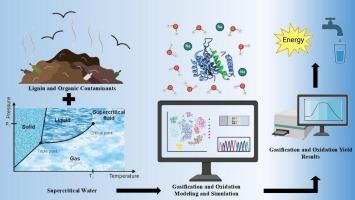Unveiling magic of supercritical water gasification and oxidation: Advances in simulation and modelling for sustainable energy production and waste management
IF 5.9
3区 工程技术
Q1 CHEMISTRY, MULTIDISCIPLINARY
Journal of Industrial and Engineering Chemistry
Pub Date : 2025-04-10
DOI:10.1016/j.jiec.2025.04.012
引用次数: 0
Abstract
Supercritical water (SCW) has emerged as an environmentally friendly reaction medium for efficiently transforming organic substances. Two key processes utilizing SCW are supercritical water gasification (SCWG) and supercritical water oxidation (SCWO), which offer efficient conversion of organic materials into useful gaseous products and harmless byproducts, respectively. SCWG involves the transforming organic substances into combustible gaseous products, which can be utilized for energy generation. Conversely, SCWO focuses on the oxidation of organic compounds, leading to the formation of innocuous byproducts. Both SCWG and SCWO processes can incorporate catalysts to enhance reaction efficiency and selectivity. The environment in a SCW process can vary based on the application or process stage, showing properties like reducing, oxidizing, nonionic, basic, acidic, or highly ionic. Modeling and simulation are crucial for understanding and optimizing SCWG and SCWO processes, guiding the design of efficient reactors for sustainable waste treatment and energy conversion.

揭开超临界水气化和氧化的魔力:可持续能源生产和废物管理的模拟和建模进展
超临界水(SCW)作为一种高效转化有机物的环境友好型反应介质而出现。超临界水气化(SCWG)和超临界水氧化(SCWO)是利用超临界水的两个关键工艺,它们分别将有机材料有效地转化为有用的气态产物和无害的副产物。SCWG涉及将有机物质转化为可燃气体产品,可用于发电。相反,SCWO侧重于有机化合物的氧化,导致无害副产物的形成。SCWG和SCWO工艺都可以加入催化剂来提高反应效率和选择性。SCW过程中的环境可以根据应用或过程阶段而变化,表现出还原性、氧化性、非离子性、碱性、酸性或高离子性等特性。建模和仿真对于理解和优化SCWG和SCWO过程,指导高效反应器的设计以实现可持续的废物处理和能量转换至关重要。
本文章由计算机程序翻译,如有差异,请以英文原文为准。
求助全文
约1分钟内获得全文
求助全文
来源期刊
CiteScore
10.40
自引率
6.60%
发文量
639
审稿时长
29 days
期刊介绍:
Journal of Industrial and Engineering Chemistry is published monthly in English by the Korean Society of Industrial and Engineering Chemistry. JIEC brings together multidisciplinary interests in one journal and is to disseminate information on all aspects of research and development in industrial and engineering chemistry. Contributions in the form of research articles, short communications, notes and reviews are considered for publication. The editors welcome original contributions that have not been and are not to be published elsewhere. Instruction to authors and a manuscript submissions form are printed at the end of each issue. Bulk reprints of individual articles can be ordered. This publication is partially supported by Korea Research Foundation and the Korean Federation of Science and Technology Societies.

 求助内容:
求助内容: 应助结果提醒方式:
应助结果提醒方式:


